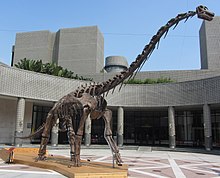User:Jeanflow/sandbox
| Somphospondyli | |
|---|---|

| |
| Skeleton of Qiaowanlong | |
| Scientific classification | |
| Domain: | Eukaryota |
| Kingdom: | Animalia |
| Phylum: | Chordata |
| Clade: | Dinosauria |
| Clade: | Saurischia |
| Clade: | †Sauropodomorpha |
| Clade: | †Sauropoda |
| Clade: | †Macronaria |
| Clade: | † Camarasauromorpha
|
| Clade: | † Titanosauriformes
|
| Clade: | †Somphospondyli Wilson & Sereno, 1998 |
| Genera | |
Somphospondylans are an
The name Somphospondyli is derived from the Greek "somphos" meaning spongy and "spondylos" meaning vertebra.[1] One of the most unique features of Somphospondylans is the spongy composition of the presacral vertebrae.[1] Being titanosauriforms, members of Somphospondyli were among the largest land-dwelling dinosaurs known to exist.
Classification
Somphospondylans were first defined by Wilson & Sereno (1998) as "the most inclusive clade that includes
Characteristics
Somphospondylans share the following
- Cervical neural arch laminae are reduced. In contrast with the cervical neural arches of Camarasaurus, those of Euhelopus and Malawisaurus are not as well-developed.
- Presacral vertebrae are composed of spongy bone. Saltasaurus vertebrae are characterized by a spongy interior, as are that of Euhelopus and titanosaurs.
- Anterior to mid-dorsal neural spines are posterodorsally inclined. These are observed in titanosaurs including Opisthocoelicaudia.
- Six sacral vertebrae (one dorsosacral added).
- Scapular glenoid are deflected medially. This differs from the laterally beveled scapular glenoid of Brachiosaurus.
Additional features found as diagnostic of this clade by Mannion et al. (2013) include the possession of at least 15
Cladistics
There exists some uncertainty in the classification of individual Somphospondylan sub-taxa.
The following cladograms show Somphospondyli membership at increasing resolutions.
Wilson & Sereno (1998)
Adapted from Wilson & Sereno (1998), the cladogram below describes the relationships between Somphospondyli and its nearest relatives.[1]
| Sauropodomorpha |
| ||||||
Taylor (2009)
The following cladogram constructed from Taylor (2009) highlights Brachiosauridae and Somphospondyli, the branching constituent clades of Titanosauriformes.[6]
| Titanosauriformes |
| ||||||
Elliott et. al. (2014)
Elliott et. al. (2014) derives a cladogram of Somphospondyli with a species-level resolution.[7]
| Somphospondyli |
| |||||||||||||||||||||||||||||||||||||||||||||||||||||||||||||||||||||||||||||||||||||||||||||||||||||||||||||||||||||||||||||||||||||||||||||||||||||||||||||||||||||||||||||||||||||||||||||||||||||||||||||||||||||||||||||||||
Paleogeography
Somphospondylans were absent from Antarctica and Australasia during the Late Jurassic, although titanosauriformes were found in Africa, Europe, the Americas, and Pakistan at that time.[2] The Middle Jurassic Ardley tracksite in the UK provides evidence for an earlier origin of titanosaurs, or derived somphospondylans[8]. Somphospondylans became the dominant sauropods by the Cretaceous, reaching every continent with the exception of Antarctica.[2]
Some Somphospondylans are believed to have existed exclusively in inland environments.[9] This is a result of “wide-gauge”trackway remnants of Somphospondylans found to be indicative of terrestrial sauropods.
